Archive:Functional and activity limitations statistics
- Data extracted in December 2017. Most recent data: Further Eurostat information, Main tables and Database. Next update of the article: February 2018.
This article presents an overview of limitations due to health issues reported by people in the European Union (EU). The first part focuses on general long-standing limitations in usual activities due to health problems. The second part looks at three types of specific limitations: functional (physical and sensory) limitations; limitations in personal care activities; and limitations in household activities. Data on functional and activity limitations are used as measures of disability (see the data sources and availability section for more information).
This article is one of a set of statistical articles concerning health status in the EU which forms part of an online publication on health statistics.
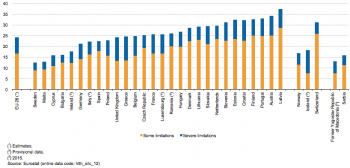
(%)
Source: Eurostat (hlth_silc_12)
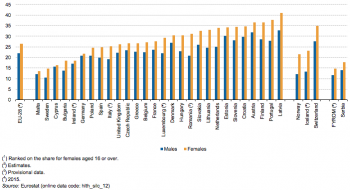
(%)
Source: Eurostat (hlth_silc_12)

(%)
Source: Eurostat (hlth_silc_12)

(%)
Source: Eurostat (hlth_silc_12)
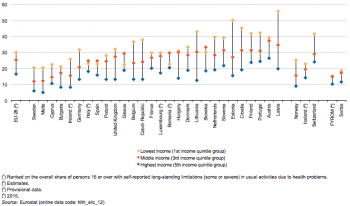
(%)
Source: Eurostat (hlth_silc_12)
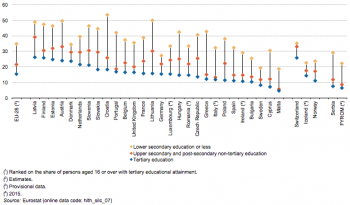
(%)
Source: Eurostat (hlth_silc_07)
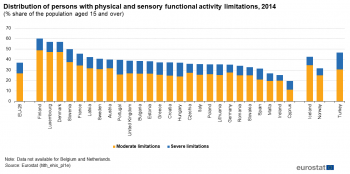
(%)
Source: Eurostat (hlth_ehis_pl1e)

(%)
Source: Eurostat (hlth_ehis_pl1e)
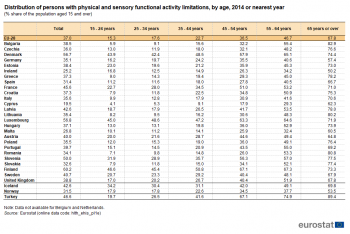
(%)
Source: Eurostat (hlth_ehis_pl1e)
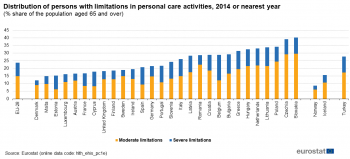
(%)
Source: Eurostat (hlth_ehis_pc1e)
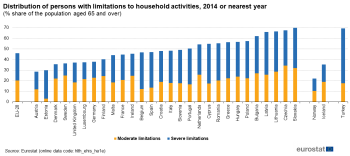
(%)
Source: Eurostat (hlth_ehis_ha1e)

(%)
Source: Eurostat (hlth_ehis_pc1e)

(%)
Source: Eurostat (hlth_ehis_ha1e)
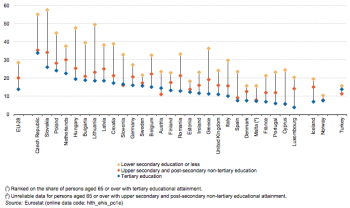
(%)
Source: Eurostat (hlth_ehis_pc1e)
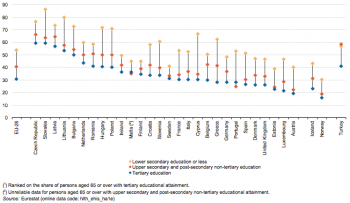
(%)
Source: Eurostat (hlth_ehis_ha1e)
Main statistical findings
About one quarter of the EU-28 population experienced long-standing limitations due to health problems
In the EU-28, 24.3 % of the population aged 16 and over reported (some or severe) long-standing limitations in their usual activities due to health problems (hereafter referred to as long-standing limitations) in 2016; 16.8 % reported some long-standing limitations and 7.5 % reported severe long-standing limitations (see Figure 1).
Across the EU Member States, the share of people who reported some or severe long-standing limitations ranged from 16 % in Cyprus to 33 % in Portugal, with Sweden (12.6 %) and Malta (12.9 %) below this range and Austria (34.2 %) and Latvia (37.4 %) above it. The highest shares of people reporting severe long-standing limitations were registered in Luxembourg (2015) Austria, Belgium, Croatia, the United Kingdom and Greece, as well as Iceland (2015), all 9 % or higher.
In 2016, men were less likely than women to report long-standing limitations — either some or severe — in all of the EU Member States (see Figure 2). The largest gender gaps were in Romania, Portugal, the Netherlands, Lithuania, Latvia and Finland, as well as Norway and Iceland (2015) all in excess of 8 percentage points; the smallest gaps were in Germany (0.9 percentage points) and Cyprus (0.7 percentage points).
A further analysis shows that this gender gap was present regardless of the severity of the limitations (Table 1). In 2016, the share of the population reporting severe long-standing limitations was 1.4 percentage points higher among women than among men in the EU-28. Among the EU Member States this gap reached 2.5 percentage points or more in Luxembourg (2015), Estonia, Latvia and Romania (2015) as well as Norway; while in Iceland the gap was 5.3 percentage points. Just in Malta, the share of the population reporting severe long-standing limitations was higher among men than among women (a difference of 0.4 percentage points).
The prevalence of long-standing limitations increased with age as did the gender health gap
Self-reported long-standing limitations also have a distinct age pattern as more people tended to report some or severe long-standing limitations in higher age groups than in lower age groups (see Figure 3). 8 % of the age group 16-24 reported (some or severe) long-standing limitations, a share that rose to 73.3 % for people aged 85 and over.
The gender health gap concerning (some and severe) long-standing limitations could be observed in all age groups: in the EU-28 the gap was lowest for the age groups 16-24 and 25-34 (1.2 and 1.3 percentage points higher for women, respectively) and broadly increased with age to peak among people aged 75-84 and 85 and over (both 6.8 percentage points higher for women). However, when focusing just on those reporting severe long-standing limitations, the gender gap was relatively small up to and including the age group 65-74; for the EU-28 there was a clear gender gap for severe long-standing limitations only in the age group 75-84 (4.1 percentage points) and in the age group 85 and over (6.5 percentage points).
Long-standing limitations decreased with income
In the EU-28, 16.6 % of the population in the fifth income quintile group (the 20 % of the population with the highest income) reported long-standing limitations in 2016, compared with 20.4 % in the fourth quintile group, 25.6 % in the third quintile group, 29.3 % in the second quintile group and 30.2 % in the first income quintile group (the 20 % of the population with the lowest income). In other words the prevalence of self-reported long-standing limitations was highest in the two lowest income quintile groups and decreased progressively as income increased.
Figure 4 shows the share of the population that reported long-standing limitations for three of the income quintile groups – the highest, middle and lowest quintiles. Nearly all EU Member States showed a similar pattern, with the lowest shares of people who reported long-standing limitations recorded for the fifth income quintile group, the highest shares for the first income quintile group, and shares for the third income quintile group between these two (see Figure 4). Only four EU Member States deviated from this pattern, Italy, Spain, Greece, Romania and Slovakia, where the population with middle income was more likely to report long-standing limitations than the population with lower income. It should be noted that this is a very similar situation to that observed for self-perceived health status, where the same Member States were the exceptions to the general pattern that the proportion of the population reporting good or very good health increased with income.
By far the largest difference in the share of the population reporting long-standing limitations between the populations in the highest and lowest income quintiles was observed in Latvia (36 percentage points), followed by Estonia (34.6 percentage points) and Lithuania (30.2 percentage points). In contrast, relatively little difference in the shares of self-reported long-standing limitations was observed between the highest and lowest income groups in Romania, Greece and Italy.
Higher educated people less likely to report long-standing limitations
There are also clear differences when looking at the relationship between self-reported long-standing limitations and educational attainment levels (see Figure 5). In the EU-28, 35 % of the population having completed at most lower secondary education, 21.6 % of the population having completed upper secondary or post-secondary non-tertiary education, and 15.3 % of the population having completed tertiary education reported long-standing limitations in 2016. The health gap between educational attainment levels was apparent in nearly all EU Member States, generally with the same pattern as observed for the EU-28 as a whole. The only exceptions were Malta, Italy and Portugal, where there was no substantial difference in the share of people reporting long-standing limitations among people having completed tertiary education and among those with at most upper secondary or post-secondary non-tertiary education.
The largest gap in the share of the population reporting some or severe long-standing limitations between those with the highest and the lowest educational attainment levels was observed in Croatia (35.4 percentage points), followed by Lithuania (34.4 percentage points) and Greece (30.6 percentage points). The smallest gaps were observed in Sweden, Denmark (both 11.1 percentage points), Germany (11.9 percentage points) and Malta (14.1 percentage points) (see Figure 5).
Functional and activity limitations
The second wave of European health interview survey (EHIS) was conducted between 2013 and 2015 and surveyed persons aged 15 and over. It included questions for the evaluation of the health state of the population, which among others, recorded the prevalence of main physical and sensory functional limitations (for example, related to vision, hearing or walking). Specifically, elder persons (aged 65 or over) were also asked whether they had difficulty in doing certain types of activities, the latter grouped into personal care activities (for example feeding or dressing) or household activities (for example preparing meals or doing housework).
On average, at EU-28 level, more than 60 % of the population reported no physical or sensory limitations, whereas more than 75 % and 50 % of the elderly reported no difficulties in performing personal care and household activities, respectively.
More than one third of the EU’s population reported limitations with respect to physical and sensory functional activities
37 % of the EU-28 population aged 15 and over reported (moderate or severe) limitations with respect to physical or sensory activities; 26.8 % of the respective population reporting moderate functional limitations of this type and another 10.1 % reporting severe functional limitations of this type (see Figure 6).
The respective shares recorded at national level differed to a lesser or greater extent from the EU-28 ones. Rates for (moderate or severe) physical and sensory limitations ranged from 19.5 % in Cyprus to 60.2 % in Finland. Severe physical and sensory limitations were most prevalent in Portugal, Hungary, Croatia, Slovenia, the United Kingdom, Greece and Bulgaria; being reported by at least 12 % of the reference population. By contrast, less than 6 % of the population in Ireland reported severe limitations of this type.
Limitations with respect to physical and sensory activities were more prevalent among women than men
An analysis by sex indicates that the proportion of women that reported (moderate or severe) physical and sensory limitations was higher than that of men: this was observed for all EU Member States with a small exception in Luxembourg, where the respective share was higher for men than that for women by 1.5 percentage points (Table 2). The pattern was the same across all EU countries, except for Norway, as far as severe limitations of this type are concerned. The highest recorded rates for women with severe limitations with respect to physical or sensory activities were recorded in Portugal, Hungary, Croatia, Bulgaria, Estonia, Slovenia and Greece.
More than two thirds of people aged 65 or over reported physical and sensory activity limitations
Age is another important factor that may explain differences in health limitations. Between 4 % and 6 % of people aged 15-24 in Cyprus and Bulgaria reported any physical or sensory limitations and this share peaked at 45 % or more in Luxembourg and Finland (see Table 3). Among those aged 45 to 64, the share of persons reporting physical and sensory limitations exceeded 50 % in five Member States, namely, France, Slovenia, Denmark, Luxembourg and Finland. Moving to the oldest age group, at EU-28 level, around two thirds of persons aged 65 and over reported such type of limitations, a share that peaked at 80 % or more in Lithuania, Romania and Bulgaria.
More than one fifth of persons aged 65 and over reported limitations in personal care activities
In relation to personal care activities, Figure 7 shows that, on average, about 24 % of the population aged 65 and over reported (moderate or severe) difficulties in personal care activities, of which about 15 % considered them as moderate and about 9 % as severe.
At country level, in five countries, namely the Netherlands (33.1 %), Lithuania (33.9 %), Poland (34.3 %), the Czech Republic (39.2 %) and Slovakia (40.2 %), one third or more of the elder population reported having (moderate or severe) difficulties in performing personal care activities.
At most 5 % of people aged 65 and over reported that such limitations are severe in Denmark, Sweden, Austria and Malta, while this share increased to more than 12 % in Greece, Lithuania and Bulgaria, peaking at 16.7 % in Belgium.
More than 4 out of 10 persons aged 65 and over reported limitations in household activities
More than half of the elderly in 12 EU Member States reported (moderate or severe) limitations in household activities; the highest rates being recorded in the Czech Republic (67.5 %) and Slovakia (69.9 %) (Figure 8). There was a relatively low proportion of the elderly reporting limitations in household activities in Denmark, Sweden, the United Kingdom, Luxembourg and Germany, while Austria, Estonia, as well as Norway each reported that in excess of 3 in 10 elder persons had (moderate or severe) difficulties in performing household activities.
Turning to elder persons with severe limitations in household activities, just in nine EU Member States (Sweden, Denmark, Germany, Luxembourg, Finland, Austria, the United Kingdom, Ireland and France) as well as Iceland and Norway, the respective rate was lower than the EU-28 average (25.8 %). It exceeded 35 % in Bulgaria (35.2 %), Cyprus (37.4 %), Lithuania (37.9 %), Slovakia (38 %) and Latvia (40.4 %).
Within the elder population, limitations with respect to personal care or household activities were more prevalent among women
Rates for the elders reporting limitations in personal care and household activities differed between the two sexes, with elder women exhibiting higher (moderate or severe) rates than elder men across all EU Member States (Table 4). At EU-28 level, elder women reporting difficulties in preforming personal care activities was 27.5 %, while the respective rate for elder men was 18.7 %. . Similarly, on average, a larger share of elder women (54.3 %) than men (35.3 %) reported limitations in household activities (Table 5).
Limitations with respect to personal care or household activities were more prevalent among elders with low educational attainment
In all 28 Member States, among the population aged 65 and over, the share of persons reporting limitations in personal care activities was higher for those with at most lower secondary education, as compared to those having completed upper secondary education or post-secondary non-tertiary education or higher (Figure 9). The largest gap between educational attainment levels among elder population reporting limitations in personal care activities was recorded in Hungary, Lithuania and Slovakia in contrast to Estonia and Sweden, where this education related gap was considerably smaller. The educational level seemed to have also an impact on the share of persons reporting limitations in household activities: 53.9 % of the EU-28 population aged 65 or over with at most lower secondary educational attainment considered having moderate or severe limitations in undertaking household activities, as compared to 31 % for those in the same age group but with tertiary level of education (see Figure 10). Across Member States, this share was by more than 30 percentage points higher for those with at most lower secondary education and those with a tertiary education degree in Hungary, Greece and Cyprus.
Data sources and availability
Self-reported long-standing limitations in usual activities due to health problems
The data used in the article concerning self-reported long-standing limitations are derived from EU statistics on income and living conditions (EU-SILC). This source is documented in more detail in this background article which provides information on the scope of the data, its legal basis, the methodology employed, as well as related concepts and definitions.
The variables collected are used to assess the limitations people have experienced — because of health problems — in carrying out usual activities for at least six months; the resulting measure is called the global activity limitation indicator (GALI), which is used as a proxy to measure disability and to calculate the healthy life years indicator. GALI, together with variables on self-perceived health and chronic morbidity (see the article on Self-perceived health statistics) constitute the minimum European health module.
The general coverage of EU-SILC is all private households and their members (who are residents at the time of data collection); this therefore excludes people living in collective households. Data refer to the population aged 16 years or over.
Functional and activity limitations
The data concerning functional and activity limitations come from the European health interview survey (EHIS). This source is documented in more detail in this background article which provides information on the scope of the data, its legal basis, the methodology employed, as well as related concepts and definitions.
The second wave of the EHIS was conducted in all EU Member States during 2013–2015 according to European Commission Regulation 141/2013 and its subsequent amendment to take account of the accession of Croatia to the EU (European Commission Regulation 68/2014). The data presented here are the results for individual EU Member States from this second wave of the survey.
Physical and sensory functional limitations refer to the extent of the severity of at least one limitation self-reported by the population aged 15 in what concerns vision, hearing and walking. Respondents evaluated the extent of their difficulties on the following scale: no difficulty, some difficulty (in this article referred to as moderate difficulties), a lot of difficulty and cannot do at all (both referred to as severe difficulties).
Limitations in personal care activities show the severity of difficulties in at least one personal care activity covering feeding, getting in and out of a bed or a chair, dressing and undressing, using a toilet, bathing or showering based on the self-reports of the population aged 65 or over.
Limitations in household activities show the severity of difficulties in at least one household activity covering preparing meals, using the telephone, shopping, managing medication, carrying out light housework, carrying out occasional heavy housework, taking care of finances and everyday administrative tasks based on the self-reports of the population aged 65 or over. It should be noted that there may be other than health reasons behind difficulties doing household activities.
Limitations of the data
All of the indicators presented in this article are derived from self-reported data so they are, to a certain extent, affected by respondents’ subjective perception as well as by their social and cultural background.
EU-SILC and the EHIS do not cover the institutionalised population, for example, people living in health and social care institutions who are more likely to face limitations than the population living in private households. It is therefore likely that, to some degree, both of these data sources under-estimate the share of the population facing limitations. Furthermore, the indicators presented are not age-standardised and thus reflect the current national age structures. Finally, despite substantial and continuous efforts for harmonisation, the implementation of EU-SILC and EHIS is organised nationally, which may impact on the results presented, for example, due to differences in the formulation of questions or their precise coverage.
Context
In November 2010, the European Commission adopted a European disability strategy for the period 2010–20. For people with disabilities, this aims at improving their social inclusion, their well-being and enabling them to fully exercise their rights. The strategy is based on the United Nations Convention on the Rights of Persons with Disabilities. In order to foster the inclusion of people with disabilities, the European Commission identified eight areas for joint action between the EU and Member States.
- Accessibility: make goods and services accessible to people with disabilities and promote the market of assistive devices.
- Participation: ensure that people with disabilities enjoy all benefits of EU citizenship; remove barriers to equal participation in public life and leisure activities; promote the provision of quality community-based services.
- Equality: combat discrimination based on disability and promote equal opportunities.
- Employment: raise significantly the share of persons with disabilities working in the labour market.
- Education and training: promote inclusive education and lifelong learning for students and pupils with disabilities; equal access to quality education and lifelong learning enable disabled people to participate fully in society and improve their quality of life.
- Social protection: promote decent living conditions, combat poverty and social exclusion.
- Health: promote equal access to health services and related facilities.
- External action: promote the rights of people with disabilities in the EU enlargement and international development programmes.
Indicators on functional and activity limitations are included in the health status chapter of the European core health indicators (ECHI).
See also
Online publications
Health status
Methodology
General health statistics articles
Further Eurostat information
Database
- Health status and determinants (health_state)
- Health status (hlth_state)
- Functional and activity limitations (hlth_fal)
- Health status (hlth_state)
Dedicated section
Methodology / Metadata
- European health interview survey (ESMS metadata file — hlth_det_esms)
- Health variables of EU-SILC (ESMS metadata file — hlth_silc_01_esms)
Source data for tables and figures (MS Excel)
External links
- European Commission — Directorate-General for Health and Food Safety — European Core Health Indicators (ECHI)
- European Commission — Directorate-General for Health and Food Safety — Social determinants and health inequalities
- European Commission — Directorate-General for Employment, Social Affairs & Inclusion — Indicators of the health and long-term care strand developed under the Open Method of Coordination on social protection and social inclusion
- European Disability Strategy 2010-2020
- Regulation (EU) No 282/2014 of the European Parliament and of the Council of 11 March 2014 on the establishment of a third Programme for the Union's action in the field of health (2014-2020)
- Report on health inequalities in the European Union (SWD(2013) 328 final) — European Commission Staff Working Document